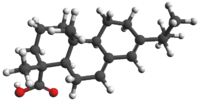Abietic acid
 |
|
 |
|
| Names | |
|---|---|
|
IUPAC name
Abieta-7,13-dien-18-oic acid
|
|
| Other names
(1R,4aR,4bR,10aR)-7-Isopropyl-1,4a-dimethyl-1,2,3,4,4a,4b,5,6,10,10a-decahydrophenanthrene-1-carboxylic acid; Abietinic acid; Sylvic acid
|
|
| Identifiers | |
|
514-10-3 |
|
| 3D model (Jmol) | Interactive image |
| ChEBI |
CHEBI:28987 |
| ChEMBL |
ChEMBL71893 |
| ChemSpider |
10127 |
| ECHA InfoCard | 100.007.436 |
| EC Number | 208-173-3 |
| KEGG |
C06087 |
| PubChem | 10569 |
| RTECS number | TP8580000 |
| UNII |
V3DHX33184 |
|
|
|
|
| Properties | |
| C20H30O2 | |
| Molar mass | 302.46 g·mol−1 |
| Appearance | Yellow resinous powder, crystals or chunks. Monoclinic plates (from EtOH/water). Colorless solid when pure. |
| Density | 1.06 g/mL |
| Melting point | 172–175 °C (342–347 °F; 445–448 K) |
| Insoluble | |
| Solubility in other solvents | Very soluble in acetone, petroleum ether, Et2O, and ethanol |
| Hazards | |
| Main hazards | Irritant |
| Safety data sheet | MSDS |
| R-phrases | R36/37/38 |
| S-phrases | S26 S36 |
| NFPA 704 | |
|
Except where otherwise noted, data are given for materials in their standard state (at 25 °C [77 °F], 100 kPa).
|
|
|
|
|
| Infobox references | |
Abietic acid (also known as abietinic acid or sylvic acid) is an organic compound that occurs widely in trees. It is the primary component of resin acid, is the primary irritant in pine wood and resin, isolated from rosin (via isomerization) and is the most abundant of several closely related organic acids that constitute most of rosin, the solid portion of the oleoresin of coniferous trees. Its ester or salt is called an abietate.
Abietic acid is extracted from tree rosin. The pure material is a colorless solid, but commercial samples are usually a glassy or partly crystalline yellowish solid that melts at temperatures as low as 85 °C (185 °F).
It belongs to the abietane diterpene group of organic compounds derived from four isoprene units. It is used in lacquers, varnishes, and soaps, and for the analysis of resins and the preparation of metal resinates. It is found in Pinus insularis (Khasi Pine), Pinus kesiya Royle, Pinus strobus (Eastern White Pine), and Pinus sylvestris (Scots Pine).
Rosin has been used for centuries for caulking ships. It is also rubbed on the bows of musical instruments to make them less slippery. In modern times methods have been developed for improving the properties of the rosin acids, which are otherwise soft, tacky, and low-melting and subject to rapid deterioration by oxidation in air. Stability is greatly increased by heat treatment.
...
Wikipedia

